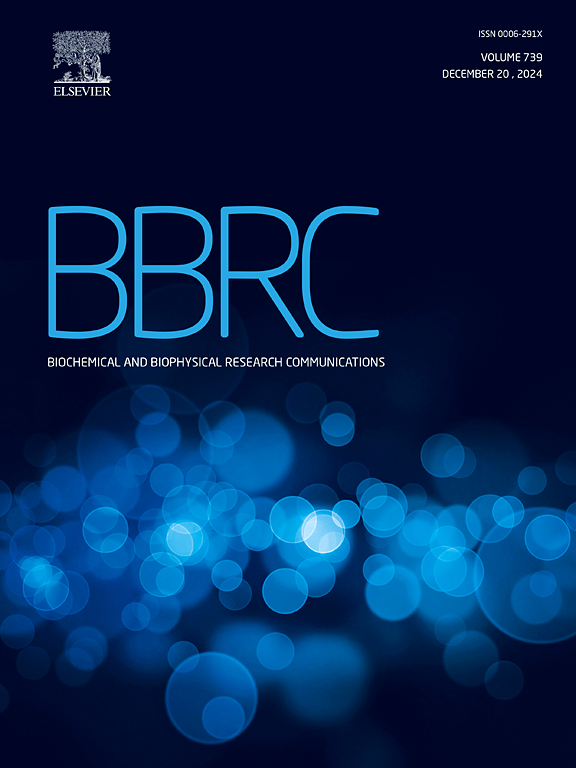抑制骨细胞凋亡不能阻止铁超载引起的骨吸收和骨质流失。
IF 2.2
3区 生物学
Q3 BIOCHEMISTRY & MOLECULAR BIOLOGY
Biochemical and biophysical research communications
Pub Date : 2025-01-01
DOI:10.1016/j.bbrc.2024.151152
引用次数: 0
摘要
铁超载导致骨细胞凋亡和核因子κ κ受体激活因子-Β配体(RANKL)的表达增加,从而加速破骨细胞的发生。由于骨细胞是RANKL的主要产生者,我们假设凋亡的骨细胞增加了RANKL在骨细胞中的表达,从而刺激破骨细胞的发生和骨吸收。在这项研究中,阿仑膦酸盐或IG9402(一种不抑制骨吸收的双膦酸盐类似物)抑制铁超载诱导的骨细胞凋亡并增加RANKL表达。两种bp均能抑制成骨细胞凋亡,但不抑制成骨细胞RANKL的升高。阿仑膦酸钠,而不是IG9402,可以阻止铁超载小鼠破骨细胞生成和血清I型胶原蛋白c -末端肽(CTX)水平的增加。阿仑膦酸钠还能防止铁超载引起的股骨骨密度降低、骨微结构破坏和骨强度减弱。虽然IG9402不能防止铁超载导致的骨质流失,但它可以部分阻止强度的降低,这表明骨细胞活力有助于维持骨强度。总之,尽管铁超载时骨细胞凋亡导致骨细胞RANKL产生增加。然而,阻断这些事件不足以抑制铁超载诱导的破骨细胞发生和骨质流失。本文章由计算机程序翻译,如有差异,请以英文原文为准。
Inhibition of osteocyte apoptosis does not prevent iron overload-induced bone resorption and bone loss
Iron overload leads to apoptosis and increased expression of receptor activator of nuclear factor kappa‐Β ligand (RANKL) in osteocytes, which in turn accelerates osteoclastogenesis. Since osteocytes are the main RANKL producers, we hypothesized that apoptotic osteocytes increase RANKL expression in osteocytes, which in turn stimulates osteoclastogenesis and bone resorption. In this study, alendronate or IG9402, a bisphosphonate (BP) analog which does not inhibit bone resorption, inhibited iron overload-induced osteocyte apoptosis and increased RANKL expression. Both BPs also prevented osteoblast apoptosis but did not inhibit the increase in osteoblastic RANKL. Alendronate, but not IG9402, prevented the increase in osteoclastogenesis and serum levels of the bone resorption marker C-telopeptide of type I collagen (CTX) in iron-overloaded mice. Alendronate also prevented the iron overload-induced reduction in femoral bone mineral density, disruption of bone microstructure, and weakness of bone strength. Although IG9402 did not prevent bone loss due to iron overload, it partially prevented reduction of strength, suggesting that osteocyte viability contributes to the maintenance of bone strength. In conclusion, although osteocyte apoptosis in the presence of iron overload leads to an increase in osteocytic RANKL production. However, blocking these events was not sufficient to inhibit iron overload-induced osteoclastogenesis and bone loss.
求助全文
通过发布文献求助,成功后即可免费获取论文全文。
去求助
来源期刊
CiteScore
6.10
自引率
0.00%
发文量
1400
审稿时长
14 days
期刊介绍:
Biochemical and Biophysical Research Communications is the premier international journal devoted to the very rapid dissemination of timely and significant experimental results in diverse fields of biological research. The development of the "Breakthroughs and Views" section brings the minireview format to the journal, and issues often contain collections of special interest manuscripts. BBRC is published weekly (52 issues/year).Research Areas now include: Biochemistry; biophysics; cell biology; developmental biology; immunology
; molecular biology; neurobiology; plant biology and proteomics

 求助内容:
求助内容: 应助结果提醒方式:
应助结果提醒方式:


